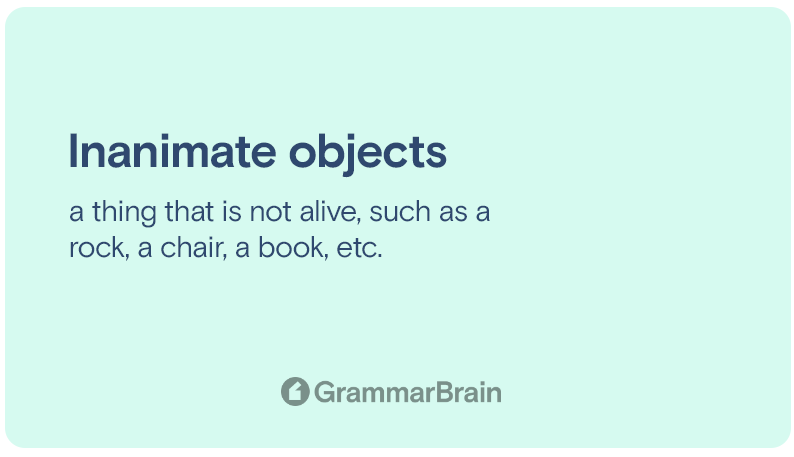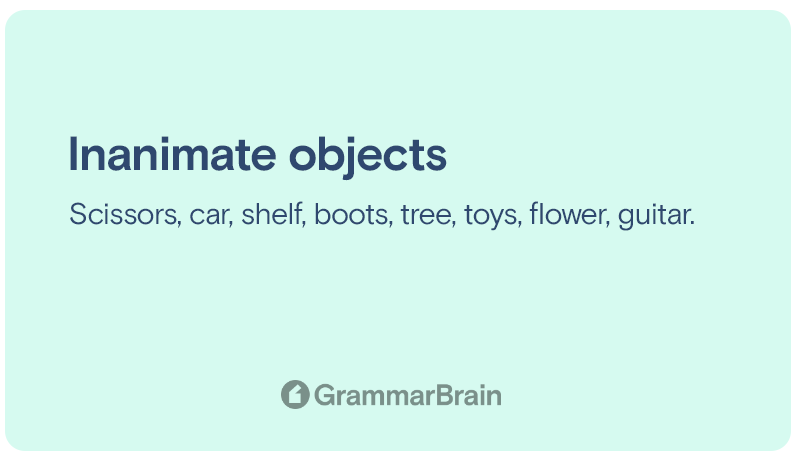What is an inanimate object? Often we hear this phrase used in many instances, but what’s more important is the proper use of it with relevant context. So, let’s see what it means, where it is more relevant, and how exactly to use the phrase.

What is an inanimate object?
An ‘inanimate object’ means any entity that is not alive or doesn’t have life. It is a two-word phrase – inanimate (meaning non-living or non-conscious) and object (meaning thing or entity), syndicating a lifeless thing. It can be anything, like a car, chair, ball, table, bag, etc.
| Form | Definition |
| Inanimate object | a thing that is not alive, such as a rock, a chair, a book, etc. |
What is the origin of an inanimate object?
The first word ‘inanimate’ is of Latin origin, which can be broken down into two parts – ‘in’ meaning “not” and ‘animatus’ meaning “alive.” Wholly, it translates to “not alive.” As for the second word ‘object’, it originates from the medieval Latin word ‘obiectum’ literally meaning “thrown against,” developing into an object, finding its roots in Old French as well. It is pronounced as in-an-uh-mit ohb-jct.
| Inanimate object list | Inanimate object list | Inanimate object list |
| Guitar | Scissors | Shelf |
| Apple | Tree | Car |
| Flower | Toys | Boots |
Inanimate object personified
In a linguistic format, it may indicate personification (a figure of speech).
For example:
- That style of apparel is inspired by clothing of medieval times.
- I think my phone likes to play hide and seek, especially when I desperately need it.
In the first example, apparel is an inanimate object personified by another inanimate object, in this case, clothing. In the second example, another inanimate object, the phone, is said “to like” and “playing” a game of hide & seek.
Now the base argument arises that if it’s an inanimate object, how can it be inspired or inspire even?
Or tend to like or play, as an animate object would do? To avoid such conundrums, we can say instead:
- The designer of that style of apparel is inspired by looking at the clothing of medieval times.
- I don’t find my phone easily, especially when I am desperately in need of it.
Inanimate object sentence examples
The word ‘inanimate’ is used as an adjective.
A few examples are:
- I wouldn’t stress so much importance over some inanimate object.
- Some people get so furious at their cars. How can someone get so angry at an inanimate object?
- Statues are such a perfect example of an inanimate object.
- Sometimes, Alina gets so attached to inanimate objects she behaves as if they were alive.
- Do you even remember the night when the lights went off, and we got scared to death by that inanimate object lying in the dark corner?
- It’s an inanimate object! Why do you care so much?
- Animals like bears undergo hibernation during the winters in snow, reducing their heartbeats automatically, but they are not to be mistaken for inanimate objects.

Conclusion
To conclude, anything which does not possess life is called an inanimate object. For example – a door, house, keys, phone, clothing, etc. It is often personified due to the flexibility of the American English language. A more literal sense of sentence structure may be used to prevent confusion for those unaware of the figure of speech.
Inside this article
Fact checked:
Content is rigorously reviewed by a team of qualified and experienced fact checkers. Fact checkers review articles for factual accuracy, relevance, and timeliness. Learn more.
Core lessons
Glossary
- Abstract Noun
- Accusative Case
- Anecdote
- Antonym
- Active Sentence
- Adverb
- Adjective
- Allegory
- Alliteration
- Adjective Clause
- Adjective Phrase
- Ampersand
- Anastrophe
- Adverbial Clause
- Appositive Phrase
- Clause
- Compound Adjective
- Complex Sentence
- Compound Words
- Compound Predicate
- Common Noun
- Comparative Adjective
- Comparative and Superlative
- Compound Noun
- Compound Subject
- Compound Sentence
- Copular Verb
- Collective Noun
- Colloquialism
- Conciseness
- Consonance
- Conditional
- Concrete Noun
- Conjunction
- Conjugation
- Conditional Sentence
- Comma Splice
- Correlative Conjunction
- Coordinating Conjunction
- Coordinate Adjective
- Cumulative Adjective
- Dative Case
- Determiner
- Declarative Sentence
- Declarative Statement
- Direct Object Pronoun
- Direct Object
- Diction
- Diphthong
- Dangling Modifier
- Demonstrative Pronoun
- Demonstrative Adjective
- Direct Characterization
- Definite Article
- Doublespeak
- False Dilemma Fallacy
- Future Perfect Progressive
- Future Simple
- Future Perfect Continuous
- Future Perfect
- First Conditional
- Irregular Adjective
- Irregular Verb
- Imperative Sentence
- Indefinite Article
- Intransitive Verb
- Introductory Phrase
- Indefinite Pronoun
- Indirect Characterization
- Interrogative Sentence
- Intensive Pronoun
- Inanimate Object
- Indefinite Tense
- Infinitive Phrase
- Interjection
- Intensifier
- Infinitive
- Indicative Mood
- Participle
- Parallelism
- Prepositional Phrase
- Past Simple Tense
- Past Continuous Tense
- Past Perfect Tense
- Past Progressive Tense
- Present Simple Tense
- Present Perfect Tense
- Personal Pronoun
- Personification
- Persuasive Writing
- Parallel Structure
- Phrasal Verb
- Predicate Adjective
- Predicate Nominative
- Phonetic Language
- Plural Noun
- Punctuation
- Punctuation Marks
- Preposition
- Preposition of Place
- Parts of Speech
- Possessive Adjective
- Possessive Determiner
- Possessive Case
- Possessive Noun
- Proper Adjective
- Proper Noun
- Present Participle
- Prefix
- Predicate



